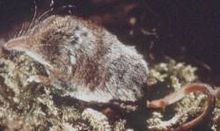Sorex
|
Sorex Temporal range: Late Miocene to Recent |
|
|---|---|
 |
|
| Cinereus shrew (Sorex cinereus) | |
| Scientific classification | |
| Kingdom: | Animalia |
| Phylum: | Chordata |
| Class: | Mammalia |
| Order: | Eulipotyphla |
| Family: | Soricidae |
| Subfamily: | Soricinae |
| Tribe: |
Soricini G. Fischer |
| Genus: |
Sorex Linnaeus, 1758 |
| Species | |
|
See text. |
|
See text.
The genus Sorex includes many of the common shrews of Eurasia and North America, and contains at least 142 known species and subspecies. Members of this genus, known as long-tailed shrews, are the only members of the tribe Soricini of the subfamily Soricinae (red-toothed shrews). They have 32 teeth.
These animals have long pointed snouts, small ears which are often not visible and scent glands located on the side of the body. As their eyesight is generally poor, they rely on hearing and smell to locate their prey, mainly insects. Some species also use echolocation. It is often difficult to distinguish between species without examining the dental pattern.
In some species, a female shrew and her dependent young form "caravans", in which each shrew grasps the rear of the shrew in front, when changing location.
...
Wikipedia
